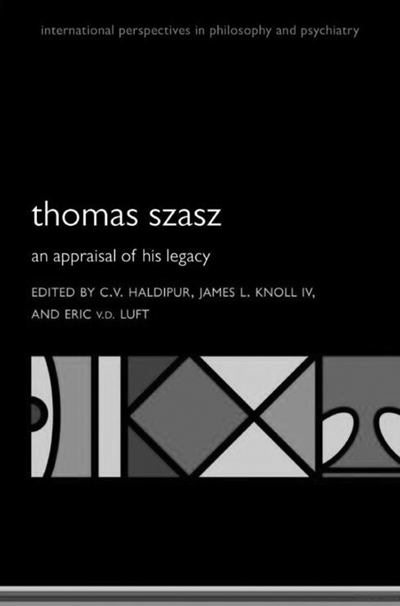
In The Myth of Mental Illness (1961), Thomas Szasz argued that there was no such thing as mental illness, that it was a human invention. In a prolific writing career, he went on to expand on this notion, asserting that the madman was responsible for everything he said and did. Szasz claimed that hallucinations were ‘disowned self conversations’ and delusions were ‘stubborn errors or lies’, both of which were ‘created’ by the patient and could be ‘stopped’ by them. He argued against compulsory detention and treatment, and against the insanity defence. In 1969 he made common cause with the Scientologists to fight against compulsory incarceration. Szasz's philosophy of freedom was a key aspect of his thought and led him to consider suicide as the ultimate act of free will. A libertarian from the political right, Szasz argued against state intervention and was opposed to the ethos of Britain's National Health Service. He favoured a type of private practice in which the patient and doctor agreed a voluntary contract.
This collection of essays by philosophers and clinicians, mainly from the USA, examines a wide range of his work. Several of the contributors knew Szasz, which enables them to provide a more personal perspective, but which can, at times, result in a lack of objectivity. What is missing is a biographical overview, which would have helped readers less familiar with Szasz or his writings. In particular, it would have been useful to know more about Szasz's clinical career. After all, in The Myth of Mental Illness, he advised that we should judge clinicians by what they do, not what they say. We do gain some information about his psychiatric practice in the chapters by Fuller Torrey and Allen Frances, who both judge that Szasz's lack of clinical experience in seeing people with major mental illness led him to make wrong-headed claims about psychiatric disorder.
Originally from Hungary, Szasz emigrated to the USA and trained at the Chicago Institute for Psychoanalysis in the 1950s, at a time when psychoanalysis held sway in American psychiatry. He later moved to Syracuse, where he saw only out-patients. Torrey speculates that it is possible that Szasz never diagnosed or treated any patients with schizophrenia and that he never had to take care of any patient who needed to be detained in hospital. He quotes Szasz as saying: ‘I have never, ever given drugs to a mental patient’. Torrey concludes that Szasz's statements about schizophrenia are ‘fatuous’ (p. 99). Frances writes that he was initially impressed when he read Szasz as a trainee, but later found that Szasz's theories were clinically impractical. He concludes: ‘Schizophrenia is only a “myth” to those with no clinical experience or life experience’ (p. 172).
Frances recalls asking Szasz what he would do if his son was hearing voices telling him to kill himself: would he favour compulsory detention? Szasz said he would intervene: ‘I am a father first and a protector of human rights second’ (p. 170). It is difficult to see this as anything other than hypocrisy: advising others to do what one would not do oneself.
Many contributors adopt a critical approach to Szasz's work. Ronald Pies takes issue with Szasz's account of the history of psychiatry. Jennifer Radden judges that expecting people to take responsibility for their symptoms seems ‘inhuman and unrealistic’ (p. 249). Stephen Wilson writes that Szasz's emphasis on individualism denies the real nature of mental illness and the suffering of patients and their families, and serves to stigmatise psychiatrists. He does concede, like several other contributors, that Szasz highlighted the dangers of arbitrary incarceration and of the unnecessary creation of new categories of mental disorder, as well as puncturing the scientific pretensions of some mental health professionals.
K. W. M. Fulford tries to find what he calls a ‘third way’ in assessing the merits and demerits of Szasz's work. He writes that Szasz was right to emphasise the importance of values in concepts of mental illness, but wrong to conclude that mental illness is a myth. His critics were right to insist that mental illness is part of medicine, but wrong to deny values. In like manner, Thomas Schramme points out that biological psychiatry believes it has ‘solved’ mind–body dualism, but all it has done is dismiss mind from the equation. Psychiatry, if it claims to be a valid science, must take account of the inner worlds of its patients.
The volume provides much erudite discussion of the key issues in psychiatry. However, the chapters that carry most impact are those written by clinicians. As Frances asks, how does one reconcile the lofty principles of the freedom of the individual with the need to help acutely psychotic patients who hear voices telling them to kill themselves? In a striking phrase with which I'm sure most psychiatrists would agree, he observes: ‘The academic perch is very different from the clinical trench’ (p. 174).



eLetters
No eLetters have been published for this article.